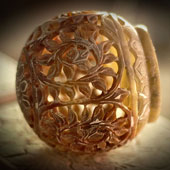Design Resource
Marble Carving - Agra
Attractive carving
by
The raw marble which is quarried at makrana in the Nagaur district of Rajasthan, acts as the chief source of marble for the craftsmen engaged in sculpting and carving of intricate jali works in the form of carved boxes and lamp shades. These craftsmen are famous for their skill and experience in these type of crafts as they inherit the same techniques of their fore fathers.
Carving is also done by using a soft stone called alabaster, due to its resemblance to marble. Being a soft stone it makes the carving easier for the craftsmen who use a minimum pressure of their fingertips to carve intricate details on the surface of the marble. Prior to the carving process the raw marble is sculpted and shaped using a hammer and a chisel to bring out the basic form of the desired product on which the patterns would be carved. The craftsmen then marks the outline of the design using a compass. Once the outline is marked, he then draws various floral and geometrical designs using a pointed chisel. This process is sometimes done by the eye alone by highly trained craftsmen who are experienced enough to accurately carve the designs without the outline. The craftsman then cuts through these pre-drawn patterns using various grades of flat chisels and hammer. This work has been further simplified by the use of a pen drill, which is driven by a motor. A drill or “barma” is also often used in case of a thick slab to pierce a hole to make frets of the design half way through the slab on one side, and then through the other side of the marble slab. A hand held pen drill not only makes the work less tiring but it also consumes less time when compared to the process of using a chisel and a hammer.
After carving, this marble block goes for further grooving and embossing, which is done by using chisels of varying sizes. The craftsman then provides minute details to the carved pattern by the process of filing, after which it is sent for polishing or buffing. Buffing is a process of polishing the surface of marble to make it smooth. It is usually done by a buffing machine which consists of a rotating wheel often coated with sand paper or hard wires made up of brass. Once the surface is smoothened it is then forwarded for final packaging.













